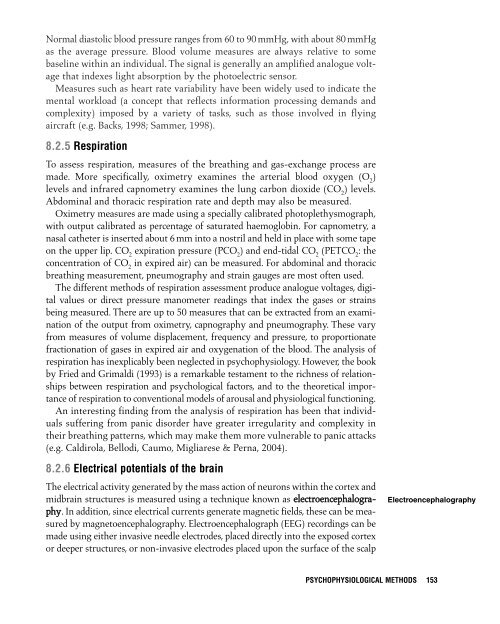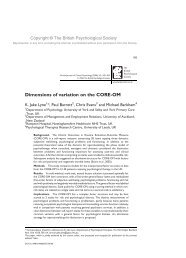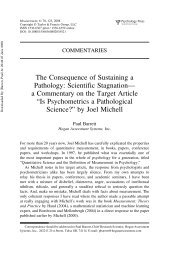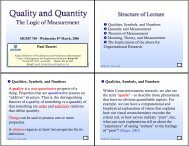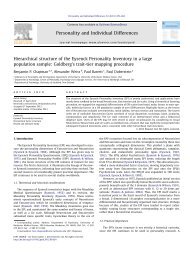Psychophysiological Methods - Paul Barrett
Psychophysiological Methods - Paul Barrett
Psychophysiological Methods - Paul Barrett
- No tags were found...
Create successful ePaper yourself
Turn your PDF publications into a flip-book with our unique Google optimized e-Paper software.
Breakwell-3389-Ch-08.qxd 2/7/2006 8:49 PM Page 153Normal diastolic blood pressure ranges from 60 to 90 mmHg, with about 80 mmHgas the average pressure. Blood volume measures are always relative to somebaseline within an individual. The signal is generally an amplified analogue voltagethat indexes light absorption by the photoelectric sensor.Measures such as heart rate variability have been widely used to indicate themental workload (a concept that reflects information processing demands andcomplexity) imposed by a variety of tasks, such as those involved in flyingaircraft (e.g. Backs, 1998; Sammer, 1998).8.2.5 RespirationTo assess respiration, measures of the breathing and gas-exchange process aremade. More specifically, oximetry examines the arterial blood oxygen (O 2)levels and infrared capnometry examines the lung carbon dioxide (CO 2) levels.Abdominal and thoracic respiration rate and depth may also be measured.Oximetry measures are made using a specially calibrated photoplethysmograph,with output calibrated as percentage of saturated haemoglobin. For capnometry, anasal catheter is inserted about 6 mm into a nostril and held in place with some tapeon the upper lip. CO 2expiration pressure (PCO 2) and end-tidal CO 2(PETCO 2: theconcentration of CO 2in expired air) can be measured. For abdominal and thoracicbreathing measurement, pneumography and strain gauges are most often used.The different methods of respiration assessment produce analogue voltages, digitalvalues or direct pressure manometer readings that index the gases or strainsbeing measured. There are up to 50 measures that can be extracted from an examinationof the output from oximetry, capnography and pneumography. These varyfrom measures of volume displacement, frequency and pressure, to proportionatefractionation of gases in expired air and oxygenation of the blood. The analysis ofrespiration has inexplicably been neglected in psychophysiology. However, the bookby Fried and Grimaldi (1993) is a remarkable testament to the richness of relationshipsbetween respiration and psychological factors, and to the theoretical importanceof respiration to conventional models of arousal and physiological functioning.An interesting finding from the analysis of respiration has been that individualssuffering from panic disorder have greater irregularity and complexity intheir breathing patterns, which may make them more vulnerable to panic attacks(e.g. Caldirola, Bellodi, Caumo, Migliarese & Perna, 2004).8.2.6 Electrical potentials of the brainThe electrical activity generated by the mass action of neurons within the cortex andmidbrain structures is measured using a technique known as electroencephalography.In addition, since electrical currents generate magnetic fields, these can be measuredby magnetoencephalography. Electroencephalograph (EEG) recordings can bemade using either invasive needle electrodes, placed directly into the exposed cortexor deeper structures, or non-invasive electrodes placed upon the surface of the scalpElectroencephalographyPSYCHOPHYSIOLOGICAL METHODS153


